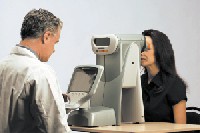All the technology we use in clinical practice has advanced or been replaced by newer technologies, except for the phoropter. This technology, too, is due for an update.
 |
The Whole System
In recent years, weve learned more about the human visual system, including the effects of optical aberrationsboth lower- and higher-order aberrations that we previously did not know existed. Adaptive optics and wavefront analysis allow us to measure the entire visual system, while traditional refraction only measures about 80% of the eyes aberrations (the lower-order aberrations).
By measuring the higher-order aberrations as well, we can seek to improve the remaining 20% of the patients vision, whether it be with refractive surgery, intraocular lenses, spectacles or contact lenses.1 When we measure and correct higher-order aberrations with customized visual correction, patientsespecially patients who have irregular corneas or who have spherical aberrations naturally or induced by laser refractive surgeryexperience improved contrast sensitivity and spatial vision over a range of distances.2 So, how can we justify continued reliance on the phoropter alone?
Admittedly, wavefront aberrometry does not measure the visual cortex, which translates the optical image, so the aberrometer cannot completely replace subjective refractionat least not anytime soon. Perhaps that will change.
Crawl, Walk and Run
Technology evolves similarly to the way we, as human beings, evolve. We start by crawling, then walking and, eventually, we start running. Currently, were crawling. In the next three to five years, well be walking, and five to 10 years after that, well be running. The fundamental basis of this last step: wavefront aberrometry.
Consider the evolution of other eye care technologies. For example, weve gone from dynamic perimetry to static computer perimetry to measure visual field defects. For glaucoma suspects, weve advanced to nerve fiber layer analysis and ocular tomography to detect glaucomatous damage that occurs before visual field defects.
Another example of evolving technology: cataract surgery. At one time, patients underwent intracapsular cataract removal and then received a high-powered spectacle correction. Today, most lensectomies involve extracapsular removal with IOL implantation.
Now, take refraction. Except for the development of autorefractors, this technology has not changed.
Affordable Option
Whenever we think about incorporating new technology into our practices, we ask whether it is affordable. The answer for wavefront aberrometry: absolutely.
Today, the average cost of an aberrometer is about $40,000. That cost will probably go down to $20,000 within five years.
And, aberrometers today can measure aberrations up to the 11th order, pupil size, point-spread function, Zernike polynomials, the combined or the individual power of the cornea or lens, and distance and near vision. This technology also allows you to assess the tear film, ocular surface and media changes as they occur in the eyenone of which can be measured at the phoropter.
Pie in the Sky?
You might argue that replacing the phoropter with an aberrometer is just pie in the sky because we do not have enough options for correcting higher-order aberrations. Besides custom LASIK, wavefront technology has already begun to play a role in other options that we can offer patients, both now and in the future. These include:
Intraocular lenses. We already have one IOL, the Tecnis IOL (Advanced Medical Optics), that uses wavefront technology.
Inlays and onlays. Researchers are working to develop synthetic materials that represent an alternative to removing corneal tissue. The idea is to mimic the corneas collagen, then shape the material so that it corrects refractive error while maintaining a prolate shape.
Contact lenses. Several companies and university research laboratories are developing custom wavefront-designed contact lenses that can neutralize higher-order aberrations. (For more on this, see The Reality of Super Vision, April 2005.)
To offer these options to your patients, youll need an aberrometer, which offers a standardized way of measuring higher-order aberrations.
Overlap
As with any transition period in ophthalmic technology, we will initially have some overlap between the newer and older technology, especially given the effects of the visual cortex. Still, I believe that reliance on the phoropter will move to the back burner as we become more comfortable and committed to a higher level of refraction, probably within the next five to 10 years.
Dr. Catania practices with a multispecialty practice in Atlantic Beach, Fla. He has done research and participated in clinical trials with wavefront aberrometry.
1. Applegate RA. Limits to vision: can we do better than nature? J Refract Surg 2000 Sep-Oct;16(5):S547-51.
2. Williams D, Yoon GY, Porter J, et al. Visual benefit of correcting higher order aberrations of the eye. J Refract Surg 2000 Sep-Oct;16(5):S554-9.

